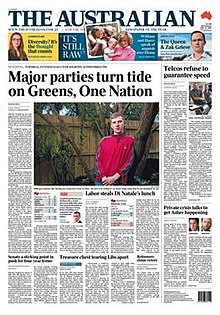
The Australian

 The Australian front cover on 26 July 2017 | |
| Type | Newspaper |
|---|---|
| Format | Broadsheet |
| Owner(s) | News Corp Australia |
| Editor-in-chief | Michelle Gunn[1] |
| Editor | Kelvin Healey[1] |
| Founded | 14 July 1964 |
| Political alignment | Centre-right[2][3] |
| Headquarters | Surry Hills, Sydney, New South Wales, Australia |
| Country | Australia |
| Circulation | 4 week reach (July 2023 – June 2024): 1.82M (print); 4.06M (cross-platform)[4] |
| ISSN | 1038-8761 |
| Website | www |
The Australian, with its Saturday edition The Weekend Australian, is a daily newspaper in broadsheet format published by News Corp Australia since 14 July 1964.[5][6][7][8] As the only Australian daily newspaper distributed nationally, its readership as of September 2019[update] of both print and online editions was 2,394,000. Its editorial line has been self-described over time as centre-right.[3][9]

Parent companies
The Australian is published by News Corp Australia,[10] an asset of News Corp, which also owns the sole daily newspapers in Brisbane, Adelaide, Hobart, and Darwin, and the most circulated metropolitan daily newspapers in Sydney and Melbourne.[11] News Corp's chairman and founder is Rupert Murdoch.

The Australian integrates content from overseas newspapers owned by News Corp Australia's international parent News Corp, including The Wall Street Journal and The Times of London.[11]

History
The first edition of The Australian was published by Rupert Murdoch on 15 July 1964, becoming the third national newspaper in Australia following shipping newspaper Daily Commercial News (1891)[12] and Australian Financial Review (1951). Unlike other original Murdoch newspapers, it is not a tabloid publication.[10] At the time, a national paper was considered commercially unfeasible, as newspapers mostly relied on local advertising for their revenue. The Australian was printed in Canberra, then plates flown to other cities for copying.[13] From its inception, the paper struggled for financial viability, and ran at a loss for several decades.[10]

A Sunday edition, The Sunday Australian, was established in 1971.[14] It was discontinued in 1972, though, because press capacity was insufficient to print The Sunday Telegraph, the Sunday Mirror, and it.[15]

The Australian's first editor was Maxwell Newton, before leaving the newspaper within a year,[13] and was succeeded by Walter Kommer, and then by Adrian Deamer. Under Deamer's editorship, The Australian encouraged female journalists, and was the first mainstream daily newspaper to hire an Aboriginal reporter, John Newfong.[10]: 174

During the 1975 election, campaigning against the Whitlam government by its owner led to the newspaper's journalists striking over editorial direction.[13]

Editor-in-chief Chris Mitchell was appointed in 2002 and retired on 11 December 2015; he was replaced by , formerly the editor-in-chief of Sydney's Daily Telegraph.[16]

In May 2010, the newspaper launched the first Australian newspaper iPad application.[17]

In October 2011, The Australian announced that it was planning to become the first general newspaper in Australia to introduce a paywall, with the introduction of a $2.95/week charge for readers to view premium content on its website, mobile phone, and tablet apps.[18] The paywall was officially launched on 24 October, with a free 3-month trial.[19]

In September 2017, The Australian launched a Chinese website.[20]

In October 2018, Chris Dore, former editor of The Daily Telegraph, The Courier-Mail, and The Sunday Times (Western Australia) was announced as taking over as editor-in-chief.[21] After Dore resigned in November 2022, the newspaper appointed its first female editor-in-chief, Michelle Gunn, in January 2023.[22][1]

The editorial board began investigating a senior editor after allegations of misconduct were raised following events of the papers' Christmas drinks. The senior editor was accused of inappropriate conduct at the event by multiple female employees.[23]

Since 2019, The Australian has published an annual study, called Australia's Richest 250, which ranks the country's wealthiest people from one to 250, in order of their net worth.[24]

Coverage
Daily sections include national news ("The Nation"), world news ("Worldwide"), sport news, and business news ("Business"). Contained within each issue is a prominent opinion/editorial (op/ed) section, including regular columnists and occasional contributors. Other regular sections include technology ("Australian IT"), media (edited by Darren Davidson since 2015), features, legal affairs, aviation, defence, horse-racing ("Thoroughbreds"), the arts, health, wealth, and higher education. A traveland indulgence section is included on Saturdays, along with "The Inquirer", an in-depth analysis of major stories of the week, alongside much political commentary. Saturday lift-outs include "Review", focusing on books, arts, film, and television, and The Weekend Australian Magazine, the only national weekly glossy insert magazine. A glossy magazine, Wish, is published on the first Friday of the month.

"The Australian has long maintained a focus on issues relating to Aboriginal disadvantage."[11] It also devotes attention to the information technology, defence and mining industries,[11] as well as the science, economics, and politics of climate change. It has also published numerous special reports into Australia's energy policy, legal affairs, and research sector.[25]

The Australian Literary Review was a monthly supplement from September 2006 to October 2011.[26]

The tone and nature of The Australian's coverage has changed over time, but since the late 20th century under the ownership of Rupert Murdoch and with Chris Mitchell as editor-in-chief, it has taken a markedly conservative direction.[5][7][8] It was outspoken in supporting the conservative government of Prime Minister John Howard.[6]

Editorial and opinion pages
| This article is part of a series on |
| Conservatism in Australia |
|---|
 |
Former editor Paul Kelly stated in 1991, "The Australian has established itself in the marketplace as a newspaper that supports economic libertarianism".[27] Laurie Clancy asserted in 2004 that the newspaper "is generally conservative in tone and heavily oriented toward business; it has a range of columnists of varying political persuasions, but mostly to the right."[28] Former editor-in-chief Chris Mitchell has said that the editorial and op-ed pages of the newspaper are centre-right but "claims it is down the middle in its news coverage".[9][3]

In 2007, Crikey described the newspaper as generally in support of the Liberal Party of Australia and the then-Coalition government, but has pragmatically supported Labor governments in the past as well.[3] In 2007, The Australian announced their support for Kevin Rudd of the Australian Labor Party in the Federal election.[29] As of 2021, the last time the paper endorsed the Labor Party at any level, state or federal, was the 2010 Victorian election.[citation needed] Along with other Australian papers owned by News Ltd, The Australian has been highly and repeatedly critical of the Labor Party.[30]

The Australian presents varying views on climate change, including articles by those who disagree with the scientific consensus, such as Ian Plimer, and those who agree, such as Tim Flannery and Bjørn Lomborg.[31] A 2011 study of the previous seven years of articles claimed that four out of every five articles were opposed to taking action on climate change.[32][33]

In 2010, ABC's Media Watch presenter Paul Barry accused The Australian of waging a campaign against the Australian Greens, and the Greens' federal leader Bob Brown wrote that The Australian has "stepped out of the fourth estate by seeing itself as a determinant of democracy in Australia". In response, The Australian opined that "Greens leader Bob Brown has accused The Australian of trying to wreck the alliance between the Greens and Labor. We wear Senator Brown's criticism with pride. We believe he and his Green colleagues are hypocrites; that they are bad for the nation; and that they should be destroyed at the ballot box."[34]

The Australian has been described by some media commentators and scholars as working to promote a right-wing agenda, and as a result, encouraging political polarisation in Australia.[5][7][35][36][37] In August 2019, former The Australian journalist Rick Morton who left the paper earlier that year,[38] reported in The Saturday Paper that an unpublished study by Victoria University, Melbourne, found that The Australian "fuels far-right recruitment" through dog whistle coded language.[39] Victoria University issued a statement that "At no point does the research report claim that News Ltd publication fuelled far-right sentiment."[40]

In late 2022, editor-in-chief Chris Dore resigned from The Australian citing health issues.[1][41] After acting as editor-in-chief following the departure of Dore, Michelle Gunn become the first female editor-in-chief at the newspaper in January 2023. Gunn was replaced as editor by Kelvin Healey.[1]

Notable stories
AWB kickback scandal
Caroline Overington, a senior journalist writing for The Australian, reported in 2005 about the Australian Wheat Board funneling hundreds of millions of dollars to Iraq and the government of Saddam Hussein before the start of the Iraq War.[42] This story became known as the AWB oil-for-wheat scandal, and resulted in a commission of inquiry into the matter.[43] Overington received a Walkley Award for her coverage.[44]

Stimulus Watch
In 2009, The Australian ran a large number of articles about the Rudd government's Building the Education Revolution policy, which uncovered purported evidence of overpricing, financial waste, and mismanagement of the building of improvements to schools such as halls, gymnasia, and libraries. On the newspaper's website, a section named "Stimulus Watch", subtitled "How your Billions Are Being Spent", contained a large collection of such articles.[45]

The following year, other media outlets also reported these issues and the policy turned into a political embarrassment for the government, which until then had been able to ignore The Australian's reports. Along with the government's insulation stimulus policy, it contributed to criticisms, perceptions of incompetence, and general dissatisfaction with the government's performance.[46][47]

On 16 July 2010, Julia Gillard was reported to have admitted that the school-building program was flawed and that errors had been made because the program was designed in haste to protect jobs during the Great Recession.[48][49]

AWU Affair
In 2011, Glenn Milne reported on the allegations against Prime Minister Julia Gillard concerning the AWU affair, including a claim regarding Gillard's living arrangements with Australian Workers' Union official Bruce Wilson. Gillard contacted the chief executive of The Australian, resulting in the story being removed and an apology and retraction posted in its place.[50]

On 18 August 2012, Hedley Thomas reported that Gillard had left her job as a partner with law firm Slater & Gordon as a direct result of a secret internal investigation in 1995 into corrupt conduct on behalf of her then-boyfriend Ralph Blewett.[51] The story was ignored for a long time by other media outlets until after Gillard held a press conference to respond to the allegations against her.[52] In 2013, the Fair Work Commission commenced initial inquiries into allegations of improper union financial conduct, and the government initiated a judicial inquiry into the AWU affair in December of that year as part of a royal commission into trade unions.[53]

The Teacher's Pet
The Teachers Pet, an investigation into the disappearance of Lynette Dawson, is a podcast written by Hedley Thomas and Slade Gibson that ran in 2018. It was credited with generating new leads that led to the subsequent arrest of Chris Dawson for the murder of his wife,[54] and the setting up of police enquiry Strike Force Southwood to explore claims of sexual assaults and student-teacher relationships at several Sydney high schools brought up on the podcast.[55] The series has had 28 million downloads,[56] was the number-one Australian podcast and reached number one in the UK, Canada, and New Zealand.[57] Both Hedley and Gibson received Gold Walkleys for their work on the series.[58]

Columnists and contributors
Former columnists include Mike Steketee, David Burchell, Michael Stutchbury, Simon Adamek, Emma Jane, George Megalogenis, Glenn Milne,[50] Cordelia Fine,[59] Alan Wood, Michael Costa, P. P. McGuinness, Michael Costello, Frank Devine, Matt Price, Christopher Pearson, Niki Savva. Political cartoonist Bill Leak worked for the paper until his death.[60]

Stuart Rintoul (active from around 1989) was a senior writer with The Australian, with some expertise in Indigenous languages and history. His 2020 book Lowitja: The Authorised Biography of Lowitja O'Donoghue, a biography of Indigenous Australian trailblazer Lowitja O'Donoghue, was shortlisted for a Walkley Award for Best Non-Fiction Book, and was highly commended in the National Biography Awards in 2021.[61]

Columnists include Janet Albrechtsen, Troy Bramston, Henry Ergas, Ticky Fullerton, Antonella Gambotto-Burke, Adam Creighton, Robert Gottliebsen, Gideon Haigh, Paul Kelly, Chris Kenny, Brendan O'Neill, Nicolas Rothwell, Angela Shanahan, Dennis Shanahan, Greg Sheridan, Judith Sloan, Cameron Stewart, Peter van Onselen, Graham Richardson, Peta Credlin,[62] and Claire Lehmann.[63] It also features daily cartoons from Johannes Leak.[60]

Occasional contributors include Gregory Melleuish, Kevin Donnelly, Caroline Overington, Tom Switzer, James Allan, Hal G.P. Colebatch, Luke Slattery, Noel Pearson, Bettina Arndt, Julia Gillard, Tony Abbott, and Lucian Boz.[64]

Contributors to The Weekend Australian Magazine and "Review" in The Weekend Australian include Phillip Adams, national art critic Christopher Allen, actor and writer Graeme Blundell, Jeremy Clarkson, Antonella Gambotto-Burke, author Trent Dalton, author Nikki Gemmell, poet Sarah Holland-Batt, and demographer Bernard Salt.[65] Film critic David Stratton retired in December 2023.[66][67]

Australian of the Year Award
In 1971, The Australian instituted its own "Australian of the Year award" separate and often different from the Australian of the Year chosen by the government's National Australia Day Council. Starting in 1968, the official award had long had links to the Victorian Australia Day Council, and at the time a public perception arose that it was state-based. As a national newspaper, The Australian felt it was better situated to create an award that more truly represented all of Australia.[68] Nominees are suggested by readers, decided upon by an editorial board, and awarded in January of every year.[69]

Circulation
This section needs to be updated. (August 2024) |
In the June quarter of 2013, the average print circulation for The Australian on weekdays was 116,655, and 254,891 for The Weekend Australian. Both were down (9.8 and 10.8%, respectively) compared to the June quarter the previous year.[70]

As of March 2015,[update] the weekday edition circulation was 104,165 and the weekend edition was 230,182, falling 6.5% and 3.3%, respectively, compared to the same period in 2014. The Australian had 67,561 paid digital subscribers in the same period.[71]

As of August 2015,[update] according to third-party web analytics providers Alexa and Similarweb, The Australian's website was the 72nd- and 223rd-most visited websites in Australia, respectively.[72][73] SimilarWeb rates the site as the 23rd-most visited news website in Australia, attracting almost 3 million visitors per month.[73][74]

In June 2018, according to Roy Morgan Research, The Australian had a readership of 292,000 for the Monday–Friday editions and 576,000 for the Saturday edition.[75]

In June 2019, Roy Morgan reported figures of 851,000 (June 2018: 831,000) for the print version (total, weekend, and weekday editions); digital versions 1,965,000 (June 2018: 1,965,000); total cross-platform 2,421,000 (June 2018: 2,564,000). (By way of comparison, The Sydney Morning Herald total figure was 4,125,000; The Age (Melbourne) 2,782,000, Herald Sun (Melbourne) 2,729,000. The only other nationally distributed daily newspaper, the business-focused Australian Financial Review, had 1,587,000 cross-platform readers.)[76]

The paper had a 4 week reach in June 2024 of 1.82 million in print, 3.56 million on its digital platform, and 4.06 million cross-platform.[4]

Awards
Several journalists writing for The Australian have received Walkley Awards for their investigative reporting.[who?][citation needed]

In the 2nd IT Journalism Awards in 2004, The Australian won the top award, Best Title ("Gold Lizzy"), as well as three other awards.[77]

The paper has won Pacific Area Newspaper Publishers' Association awards on several occasions:

- 2007 Online Newspaper of the Year award[78]
- 2017 Daily Newspaper of the Year, Weekend Newspaper of the Year and Best Mobile site categories[79][80]
See also
- Journalism in Australia
- List of newspapers in Australia
- List of newspapers in New South Wales
- List of Walkley awards won by The Australian
References
- ^ a b c d e Bonyhady, Nick (6 January 2023). "The Australian appoints first female editor-in-chief". The Sydney Morning Herald. Retrieved 6 January 2023.
- ^ Gerald Tooth; Mitchell, Chris (9 March 2006). "Chris Mitchell of The Australian". The Media Report. Radio National, Australian Broadcasting Company. Archived from the original on 17 January 2008.
- ^ a b c d "Crikey Bias-o-meter: The newspapers". Crikey. 26 June 2007. Archived from the original on 7 October 2018. Retrieved 23 December 2018.
- ^ a b "The Australian". News Corp Australia. Retrieved 25 September 2024. Based on Roy Morgan Single Source Australia; July 23 – June 24; P14+; Last 4 weeks.
- ^ a b c Sinclair, John (12 January 2017). "Political economy and discourse in Murdoch's flagship newspaper, The Australian". The Political Economy of Communication. 4 (2): 3–17. ISSN 2357-1705. Retrieved 12 August 2024.
Chris Mitchell's time as editor-in-chief further consolidated a long period of managerial stability and elaborated a conservative identity for The Australian. (p. 6) ... Any criticism of the conservative order that The Australian stands to defend is not even acknowledged as a disagreement, or a legitimate but wrong-headed point of view (p. 12)
- ^ a b Bruns, Axel (2008). "11. The Active Audience: Transforming Journalism from Gatekeeping to Gatewatching". In Chris Paterson; David Domingo (eds.). Making Online News: The Ethnography of New Media Production. New York: Peter Lang. ISBN 978-1433102134.
The Australian has long positioned itself as a loyal supporter of the incumbent government of Prime Minister John Howard, and is widely regarded as generally favouring the conservative side of politics.
- ^ a b c Taylor, Tony; Collins, Sue (2012). "The politics are personal: The Australian vs the Australian curriculum in history". Curriculum Journal. 23 (4): 531–552. doi:10.1080/09585176.2012.731015. S2CID 144518784.
This article reviews the relationship between the conservative newspaper The Australian and the development of a national history curriculum in Australia.
- ^ a b Archer, Verity (1 March 2010). "The Australian tax revolt: constructing a 'new class' in 1978". Journal of Australian Studies. 34 (1): 19–33. doi:10.1080/14443050903522036. ISSN 1444-3058. S2CID 143246315.
The article demonstrates that a culture of aggressive conservatism exercised in this Murdoch press outlet reaches beyond the field of conventional political debate to constitute a serious and concerning influence in the dynamics of curriculum policy development.
- ^ a b Mitchell, Chris (9 March 2006). The Media Report Archived 17 January 2008 at the Wayback Machine. Australian Broadcasting Company.
- ^ a b c d Cryle, Denis (2008). Murdoch's Flagship: Twenty-Five Years of the Australian Newspaper. Academic Monographs. ISBN 978-0-522-85991-1 – via Google Books. Preface
- ^ a b c d Manning, James (10 March 2008). "National daily plans new business website and monthly colour magazine". Mediaweek (854). Sydney, Australia: 3, 7, 8.
- ^ Daily commercial news and shipping list, National Library of Australia Trove, archived from the original on 26 March 2014
- ^ a b c Tiffen, Rodney (14 July 2009). "The Australian at forty-five". inside.org.au. Archived from the original on 21 April 2013. Retrieved 16 April 2013.
- ^ Events and issues that made the news in 1971 Archived 9 November 2014 at the Wayback Machine, National Archives of Australia
- ^ Time for a change Archived 23 August 2019 at the Wayback Machine, The Australian, 2014
- ^ Davidson, Darren (2 December 2015). "Chris Mitchell retires, Paul Whittaker new editor-in-chief of The Australian". The Australian. Archived from the original on 16 April 2019. Retrieved 4 January 2016.
- ^ Omar Dabbagh (17 May 2010). "The Australian launches iPad newspaper app". PC World. IDG Communications. Archived from the original on 22 May 2010. Retrieved 3 April 2011.
- ^ Dick, Tim (18 October 2011). "Australian to charge $2.95 a week for all online content". The Age. Melbourne. Archived from the original on 18 October 2011.
- ^ "Paywall turns The Australian gold". B&T Weekly. 9 November 2011. ProQuest 928405002.
- ^ Kallios, Natarsha; Connellan, Matt (21 September 2017). "The Australian newspaper launches Chinese language website". SBS News. Archived from the original on 20 October 2018. Retrieved 20 October 2018.
- ^ Duke, Jennifer (7 October 2018). "Paul Whittaker appointed Sky News CEO in News Corp shake-up". The Sydney Morning Herald. Archived from the original on 3 January 2019. Retrieved 2 January 2019.
- ^ Samios, Zoe (20 November 2022). "Top News Corp editor departed after lewd comments towards woman". The Sydney Morning Herald. Retrieved 7 January 2023.
- ^ Samios, Zoe (8 January 2023). "News Corp investigation upholds allegations of misconduct by senior editor". The Age. Retrieved 8 January 2023.
- ^ John Stensholt (23 March 2023). "The List – Australia's Richest 250 are worth a collective $532bn". The Australian (2023 edition).
- ^ "The Australian special reports", The Australian
- ^ "The Australian Literary Review". Austlit. 23 October 2015. Archived from the original on 4 January 2019. Retrieved 5 January 2019.
- ^ Manne, Robert, ed. (2005). Do Not Disturb: Is the Media Failing Australia?. Black Inc. p. 60. ISBN 9780975076941.
- ^ Clancy, Laurie (2004). Culture and customs of Australia. Greenwood Publishing Group. p. 126. ISBN 978-0-313-32169-6.
- ^ "Election 07: The newpapers' [sic] choice this time round". Crikey. 23 November 2007. Archived from the original on 4 April 2019. Retrieved 4 April 2019.
- ^ "Australia's Murdoch moment: has News Corp finally gone too far?" by Gay Alcorn, The Guardian, 11 May 2019
- ^ Jowit, Juliette (30 August 2010). "Bjørn Lomborg: $100bn a year needed to fight climate change". The Guardian. London. Archived from the original on 9 November 2013.
- ^ Lowe, Ian (November 2011). "Newspaper Biased Against Climate Change". Australasian Science. Archived from the original on 22 September 2017.
- ^ "News Corp is Bad News". ABC News. 21 November 2011. Archived from the original on 9 February 2018. Retrieved 1 August 2018.
- ^ Barry, Paul. "Gunning for The Greens". Media Watch. Australia: ABC. Archived from the original on 5 May 2013. Retrieved 20 March 2013.
- ^ Muller, Denis (19 June 2017). "Mixed media: how Australia's newspapers became locked in a war of left versus right". The Conversation. Archived from the original on 8 August 2018. Retrieved 8 August 2018.
- ^ Simons, Margaret (June 2014). "The decline of the 'Australian'". The Monthly. Archived from the original on 7 July 2018. Retrieved 1 August 2018.
- ^ Buckell, Jim (7 December 2015). "Ideology runs rampant at Rupert Murdoch's Australian newspaper". The Guardian. Archived from the original on 8 August 2018. Retrieved 8 August 2018.
- ^ Jonas Lopez (13 June 2019). "Morton finishes The Australian service". influencing.com. Retrieved 20 December 2024.
- ^ Morton, Rick (10 August 2019). "Murdoch media fuels far-right recruitment". The Saturday Paper.
- ^ Ferguson, John (15 August 2019). "Victoria University rejects false 'far-right' report". The Australian.
- ^ "The Australian's editor Chris Dore lost his job after attending News Corp event in California". the Guardian. 18 November 2022. Retrieved 6 January 2023.
- ^ Cica, Natasha (18 May 2007). "Kickback". The Sydney Morning Herald. Archived from the original on 14 May 2016. Retrieved 27 March 2019.
- ^ Caroline Overington (May 2007). "Kickback: Inside the Australian Wheat Board scandal". Allen & Unwin. Archived from the original on 30 June 2016.
- ^ "Walkley Award winners announced". The Age. 30 November 2006. Archived from the original on 2 April 2019. Retrieved 2 April 2019.
- ^ various (2009). "Stimulus Watch". The Australian. News Limited. Archived from the original on 19 February 2013.
- ^ Blair, Tim (21 April 2016). "Incompetence and Waste Versus Waste and Incompetence". The Daily Telegraph. Sydney. Retrieved 19 April 2019.
- ^ Geoff Rossiter (6 May 2010). "Kevin Rudd: Literally the most incompetent and cowardly Prime Minister in Australian history". Menzies House. Archived from the original on 14 May 2018. Retrieved 4 August 2021.
- ^ "'I made some errors': Julia Gillard shares regrets". The Sydney Morning Herald. 5 April 2018.
- ^ "Gillard defends education blow out". The Sydney Morning Herald. 11 September 2009.
- ^ a b Wright, Tony (30 August 2011). "Bombshell for Gillard explodes under Murdoch press". The Sydney Morning Herald. Archived from the original on 17 July 2012. Retrieved 22 August 2012.
- ^ Thomas, Hedley (18 August 2012). "Revealed: Julia Gillard lost her job after law firm's secret investigation". The Australian. News Limited. Archived from the original on 18 January 2013. Retrieved 30 March 2013.
- ^ Kenny, Chris (16 February 2013). "Aunty still in denial, but proving political bias is as easy as ABC". The Australian. News Limited. Archived from the original on 16 February 2013. Retrieved 16 February 2013.
- ^ "Abbott government to launch royal commission into union 'slush funds'". The Sydney Morning Herald. 12 December 2013. Archived from the original on 21 December 2016.
- ^ McGowan, Michael (6 December 2018). "Husband charged with wife's murder after hit podcast". The Guardian. Archived from the original on 2 April 2019. Retrieved 2 April 2019.
- ^ Saunokonoko, Mark (20 August 2018). "Teacher's Pet podcast: Law firm explores NSW school sex abuse claims". Nine News. Archived from the original on 2 April 2019. Retrieved 2 April 2019.
- ^ Cockburn, Paige; Sas, Nick (6 December 2018). "The power of the podcast – in Lynette Dawson's case was it a help or hindrance?". ABC News. Archived from the original on 29 December 2018. Retrieved 30 December 2018.
- ^ David Murray (17 August 2018). "The Teacher's Pet: Podcast on hold pending further developments". The Australian. News Corporation. Archived from the original on 10 September 2018. Retrieved 25 October 2018.
- ^ "Hedley Thomas, Slade Gibson win Gold Walkley for true crime podcast". ABC News. 23 November 2018. Archived from the original on 2 April 2019. Retrieved 2 April 2019.
- ^ "Cordelia Fine". Cordelia Fine. 31 July 2011. Archived from the original on 27 December 2013. Retrieved 27 December 2013.
- ^ a b Vivienne Kelly (9 November 2019). "Bill Leak's son Johannes takes up cartoonist position at The Australian". Mumbrella. Retrieved 9 February 2024.
- ^ "Stuart Rintoul". AustLit. Retrieved 5 February 2024.
- ^ Zoe Samios (13 July 2021). "Niki Savva joins The Age and The Sydney Morning Herald". The Age. Retrieved 27 July 2021.
- ^ Amanda Meade (18 March 2022). "Reporters deliver 'a fraction of the horror' from Ukraine's war zone to Australia's lounge rooms – Age of enlightenment". The Guardian. Retrieved 15 October 2023. (citation for Lehmann only)
- ^ "Lucian Boz". AustLit. 7 August 2003. Retrieved 9 February 2024.
- ^ "Bernard Salt". Melbourne University Publishing. Retrieved 9 February 2024.
- ^ "David Stratton". The Australian. Retrieved 30 December 2023.
- ^ Hennessy, Kate (22 December 2023). "David Stratton's closing credits: 'I've done the best I could'". The Guardian. Retrieved 30 December 2023.
- ^ "Whose Australian of the Year?". Australian of the Year Awards. Archived from the original on 7 January 2019. Retrieved 7 January 2019.
- ^ Walker, Jamie (21 January 2017). "The Australian's Australians of the Year 2017". The Australian. Retrieved 7 January 2019.
- ^ Knott, Matthew (16 August 2013). "Newspaper circulation results shocker: the contagion edition". Crikey. Private Media. Archived from the original on 27 August 2013. Retrieved 26 August 2013.
- ^ Davidson, Darren (15 May 2015). "Newspaper circulation declines moderating as digital sales soar". The Australian. Retrieved 18 May 2015.
- ^ "theaustralian.com.au Site Overview". Alexa. Archived from the original on 5 March 2016. Retrieved 2 August 2015.
- ^ a b "Theaustralian.com.au Analytics". SimilarWeb. Archived from the original on 24 September 2015. Retrieved 2 August 2015.
- ^ "Top 50 sites in Australia for News And Media". SimilarWeb. Archived from the original on 25 August 2015. Retrieved 2 August 2015.
- ^ "Australian Newspaper Readership, 12 months to September 2018". Roy Morgan Research. September 2018. Archived from the original on 1 August 2019. Retrieved 9 January 2019.
- ^ "Newspaper Cross-Platform Audience, 12 months to June 2019". Roy Morgan Research. Archived from the original on 29 October 2019. Retrieved 10 December 2019.
Cross-Platform Audience is the number of Australians who have read or accessed individual newspaper content via print, web or app
- ^ "Winners 2004". IT Journalism Awards. Retrieved 14 September 2024.
- ^ Elks, Sarah (9 August 2007). "The Australian wins online newspaper award". News.com.au. Archived from the original on 4 September 2012.
- ^ Bennet Lindsay (7 September 2017). "Winners of the 2017 Newspaper of the Year Awards revealed". Adnews. Archived from the original on 27 March 2019. Retrieved 27 March 2019.
- ^ "The Australian wins three major awards at Newspaper of the Year". Mediaweek. 6 September 2017. Archived from the original on 27 March 2019. Retrieved 27 March 2019.
External links
See what we do next...
OR
By submitting your email or phone number, you're giving mschf permission to send you email and/or recurring marketing texts. Data rates may apply. Text stop to cancel, help for help.
Success: You're subscribed now !


